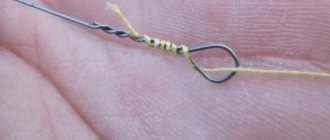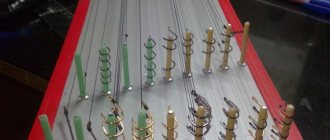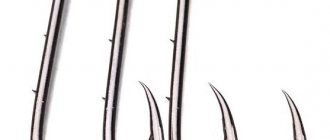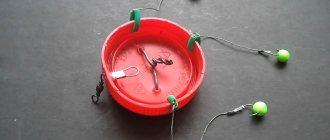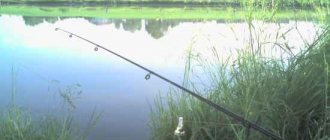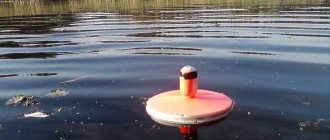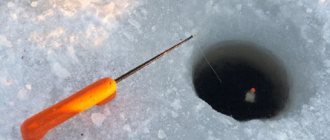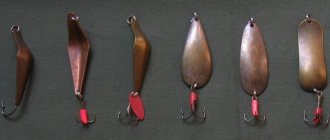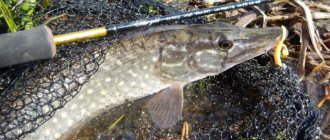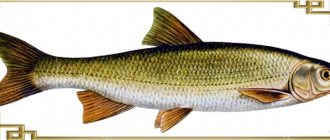The role of a leash when fishing
Artificial bait behaves differently depending on the situation.
- The bait moves separately , it interests the future victim.
- If the role of a leash is played by a thick string , then the bait loses its activity and attractiveness.
- The third option is a compromise . In this case, the leash is a thin hair, but its strength allows it to withstand heavy loads. Its plasticity is such that it allows the bait to make a variety of movements.
Relevance of application
The beneficial properties of twisting are used in many types of fishing.
- When fishing on a feeder for a diverting leash.
In this case, hard Skr. removes the leash with a hook from the feeder, which prevents the monofilaments from tangling and tangling with each other.You can also use Skr for the feeder.
- For float fishing, to equip the fishing line with several hooks.
If there is a need to install additional hooks on a fishing rod with float equipment, a small hard helps to remove the hook or leash with a hook from the main monofilament line. This equipment option is possible if the float rod is equipped using modern methods: a sliding float and a sliding sinker, limited in movement by cambrics.By moving the sinker and float to the free space of the monofilament, you can install additional hooks under or above the sinker.
- For equipping the half-bottom with bends for hooks or leashes.
A half-bottom is a fishing rod with a reel on which a fishing line with hooks is wound, at the end of which a sinker of the desired weight (usually 30-40 grams) is tied. This design allows for long casting. The bite is detected due to the activation of a signaling device from the vibration of the fishing line or due to the jerky chaotic movements of a large float freely moving along the fishing line (most often a foam ball painted in a bright color is used). In this case, the float-ball does not record the diving depth of the bait, but only signals a bite. - For equipping donks with bends with hooks or leashes.
For donkeys, you can also use Skr., SkrO and SkrOP as outlets for attaching hooks (or leashes).
Expert opinion
Knipovich Nikolai Mikhailovich
Zoologist, hydrobiologist. I am interested in fishing at a professional level.
Important! The hook and eye can be placed directly on the Skr after the formation of the Skr. Having narrowed the loop as much as possible, we thread it through the eye of the hook, thread the hook into the twist loop, and tighten the fishing line on the hook.
Characteristics of leader material for pike fishing
When choosing a material, you need to take into account the stiffness factor and the degree of visibility in the water.
- Kevlar. The material is characterized by its strength, but is soft enough to be invisible in water. Easily tied to fishing line. However, it is not difficult for the fish to snack on it.
- Titanium. This leash is a new product, but has a negative side in the form of its high cost. The material is clearly visible in water due to its shine. A pike, seeing such a bait, may not take it. The positive aspects include the long service life.
- Fluorocarbon. This is a soft material, completely invisible in water. When cast, it sinks very quickly. Fluorocarbon material has high plasticity, due to which fish are not able to break it. Disadvantage: it is easy to snack on. Fluorocarbon is not much different from fishing line, so if it is used, the thickness should be chosen up to 0.4 mm.
- Leash for pike fishing made of special material. Externally, these are threads made of thin steel, which are woven in the form of a pigtail, and on the outside there is a plastic shell. To attach it to the fishing line, it is additionally equipped with swivels and fasteners. Weight supported – 8 kg. And the length is around 30 centimeters. The material is soft, but the strength characteristics allow it to withstand the bite. There are also disadvantages, since it is visible in the water during fishing, becomes shaggy over time, and becomes twisted during fishing.
- Steel. Characterized by an increased degree of reliability. There were times, in the absence of such material, guitar strings were used as leashes for catching pike. It is impossible to bite through the leash, but it can withstand any weight. Disadvantages include its excellent visibility and clumsiness. The bait is constrained in its game.
- Tungsten. It has soft properties, with it the bait behaves independently. The disadvantages include its rapid failure during the fishing process, so it must be carefully inspected after each cast.
- Copper wire. It has the advantage of accessibility.
- Ordinary fishing line. It is available due to its low price. The fishing line has good tensile strength. Properties such as low abrasion, stretchability, good elasticity and invisible to fish in water give it good advantages.
Making fishing leads
Most often, the leash is made from a fishing line of a smaller cross-section than the main fishing line (for a float rod, jig fishing, etc.). Sometimes it breaks, and then you have to waste time replacing it. To quickly change the leash, it is advisable to have spare leashes wound on a board with 5-6 cutouts along the edges. On the board itself next to the leash it is worth indicating the length and diameter of the fishing line from which it is made. Some improvements of a skilled fisherman can also affect metal leashes, which are used on girders when catching large predators. For example, you can protect metal leads from corrosion by oxidation. The following method gives good results: leashes cleaned of fat are immersed for one hour in a 3% boiling solution of any phosphate, then washed, dried for two hours at a temperature of about 60 ° C and lubricated with oil. To avoid rust, the metal leash can simply be tinned.
When fishing with girders, you may encounter twisting and bending of metal leashes. It is not always possible to straighten them in place. But you can do it at home as follows.
The leash needs to be heated. It is more convenient to do this using a heated soldering iron. The twisted leash is secured to a ring on a wooden lining and heated along its entire length, while simultaneously stretching it.
DIY steel leashes
Recently, leashes made from guitar strings have become widespread. Spinners can easily make them at home. The main advantages of such leashes are low cost, high strength and the ability to exclude unnecessary elements from the equipment, which at least do not add reliability to the entire equipment: swivels, winding rings, carbines.
It’s very easy to make homemade metal leashes from guitar strings. Strings No. 1 and No. 2 are suitable for this. The breaking load of string No. 2 is a little more than 10 kg, and string No. 1 is about 6-8 kg. To twist the leash, you need to take a piece of string slightly longer than twice the size of the future leash. Then you need to bend the tip and twist everything together, i.e. both the tip and the main segment relative to each other. There will be a small loop where the string bends. Directly at the fishing spot, the twisted end is untwisted with your fingers and the bait is inserted into the resulting loop.
YOU SHOULD KNOW The diameter of the vole wire is 0.3 mm, like a guitar string No. 1. A leash made of such thin wire is hardly noticeable in the water and does not alarm timid predators.
That is, the leash is attached to the bait through a twist-unwind. This string leash allows you to do without any swivels or winding rings. The safety margin of such a leash is enough for 40-50 twisting and unwinding, then it loses its qualities, which can cause the fish to escape. However, a real fisherman is not limited to using a guitar string. The so-called field cable, or simply “vole”, attracts special attention from spinning anglers. This cable is marked P-274M. It consists of two twisted insulated wires. Each wire contains 3 galvanized steel and 4 copper cores. Thus, from 1 m of cable you will get 6 m of high-quality steel wire, quite suitable for making leashes. Similar wire can be found in cables of other brands, for example P-296. The advantages of this material over guitar strings are its even lower cost and the ability to purchase it to any desired length. You can buy a “vole” at most radio parts stores.
The cost of manufacturing such leashes is very low and is determined only by the time spent.
It should be noted that leashes made of this material can be used in two ways.
In one case, the angler does not unwind the twist during fishing, since the bait is replaced using an additional element of equipment - a winding ring or a carabiner. The second option provides the ability to twist and unwind directly while fishing to change bait.
In the first case, when twisting the ends of the leash, the turns can be laid as tightly as possible, in the second case , the twist at one of the ends of the leash is made quite flat, since otherwise it will be problematic to unwind the leash and twist it again.
It should be added that the difference between this material and guitar string is its lower rigidity, which makes twisting and unwinding somewhat more labor-intensive.
The strength of the rig when using field cable wire in combination with braid is determined by several factors, primarily the way the twist is made.
There are 3 main options here.
First option. The end of the wire, after bending, wraps around the main part of the leash, which remains straight. When twisting, it is easy to control the winding pitch. If it is assumed that the twist will be untwisted to change the bait directly on the pond, then a pitch of 1.5 mm can be considered optimal. The disadvantage of this twist is that it unwinds under a load of 5.5-7.0 kg.
The second option is symmetrical twisting of the end of the wire and its main part. In this case, under a static load of about 9 kg, the wire breaks at the point where the leader exits the twist. There is no spreading of the turns or weakening of the twist under load. Thus, this option turns out to be stronger than the previous one, and the symmetrical twist in this case also allows for unwinding on a pond to change bait.
Third option. It represents the first option, reinforced with additional twisting in the opposite direction. In this case, unwinding is eliminated, and the strength of such twisting is even higher than in the second option. The rupture occurs with a load of about 12 kg in the area of the leash loop. The obvious disadvantage of this option is the impossibility of twisting and unwinding while fishing.
We recommend that you always make the twist farthest from the bait double. Such a twist will obviously be more noticeable to the fish, but still not so much that it would be critical when catching common predators such as pike or pike perch.
Increasing the number of turns more than four does not affect the twist strength. However, practice shows that sharp jerks of the fish when playing can greatly weaken the spin. Therefore, the optimal number of turns for the first version of twisting can be considered 6-8, and in the case of double twisting, 5-6 lower and 3-4 upper turns can be recommended.
The pitch of the turns also has some influence on the twist strength. The tighter the turns, the more force is required to unwind the twist. Also, we should not forget that when bent, the strength characteristics of the wire decrease. It is important to remember this both when making a leash and when adjusting its shape while fishing - in all cases, you need to avoid point bends (breaks) of the wire.
Vole leashes are good in all cases when the tackle does not require strength of more than 7-9 kg. However, it should be remembered that the use of vole leashes when equipping Ultra Light class spinning rods leads to a slight decrease in the overall strength of the gear due to the weakening of the braid at the point of attachment to the leash. A solution to this problem is to use a small winding ring between the leash and the braided cord. To increase the strength of the tackle to 10-12 kg, you need to use double twisting.
As for the inevitable wear of the braid at the point of contact with the leash during fishing, this problem can be easily solved by simply periodically cutting the end of the cord and tying the knot again. It is quite enough to re-tie the leash before each new fishing trip.
Good luck to you!!!
This post may contain affiliate links. This means I earn a small commission from links used at no additional cost to you. See my privacy policy for more information.
unique, content, article, fishing, homemade, fishing, free
Tools for making a leash with your own hands
To make a leash for a pike with your own hands , you will need the following tools:
We also recommend reading:
How to properly tie a jig to a fishing line Diagram on how to learn how to tie a hook to a fishing line Tourist knots - types and methods of tying Gardner's loop for a feeder: how to tie
- Pliers with a side cut.
- Nippers with side cutting properties.
- Pliers with round jaws.
- Special pliers for fishermen that need to be used to open the winding rings.
- Diamond coated needle file set.
- Shoe's needle.
Making leashes for fishing with your own hands
Do-it-yourself fishing leashes are made in stages:
- Using side cutters, the driving material is cut to a size of 300 mm.
- Take a tube of the same size and, using a needle file, cut it and break it into two halves.
- Using a shoemaker's needle, the inner diameters of the tubes are flared.
- The resulting burrs are cleaned with a needle file.
- Insert the leash material into a tube and create loops on both sides.
- On one side of the tube there will be a leash and a small loop, and on the other there will be a loop with fittings in the form of a carbine attached to it.
- The tube must be carefully crimped with pliers.
- From the other end you should do exactly the same operation.
Fluorocarbon
Fluorocarbon material is resistant when placed in an aggressive environment. This chemical polymer has found application in fishing due to its invisibility in the water. The fishing line made of fluorocarbon does not change its characteristics under the influence of the temperature field.
The fishing line does not stretch or fray, and quickly sinks in water. Considering its high cost, it is used only as a leash, and a regular fishing line is attached to it. The material has a complex production technology, which results in its high cost. A leash made of fluorocarbon fishing line can withstand up to twenty bites, so you should constantly monitor it during the fishing process. There are technologies for coating conventional fishing line with fluorocarbonate coating.
DIY leashes
1) From pipe insulation. This method is simple and will not take you much time. To make it you need a polypropylene pipe of different diameters (smaller and larger) and bobby pins with balls at the bottom of the ends. To begin, we cut two pieces of pipe 35–40 cm long. We insert the smaller pipe into the larger one to seal the structure. We insert the invisible ones along the edge into the structure - the distance depends on the number of leashes.
Read: Equipment for a clean bottom, method
2) Leash holder made of wood. Let's take a wooden box as a basis, which you can purchase or make yourself. Everything else is simple. We hammer nails inside the box and stretch leashes between them.
Subscribe to
our channel in Yandex Zen
